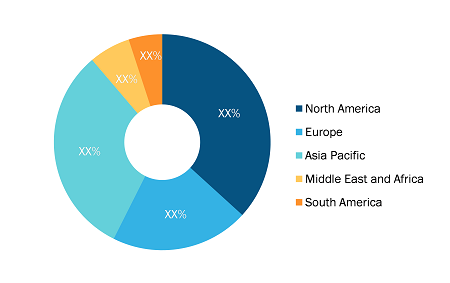Rise in Demand for Energy-Efficient Solutions Boost HVAC System Market Growth
According to our latest market study on "HVAC System Market Forecast to 2030 – COVID-19 Impact and Global Analysis – by Component, Type, Implementation, and Application," the market is expected to grow from US$ 246.10 billion in 2022 to US$ 597.7 billion by 2030; it is anticipated to grow at a CAGR of 11.3% from 2022 to 2030.
Heating, ventilation, and air conditioning (HVAC) systems utilize various technologies to control and maintain the qualitative aspects of indoor air. HVAC systems are experiencing widespread adoption owing to the features provided in this equipment or systems and their benefits amid climate change and temperature needs. Such factors promoted revenue generation of HVAC system market players. Traditional or old air conditioning (AC) units can cause 100 million metric ton of greenhouse gas emissions annually. Nearly 200 countries have signed an environmental agreement to solve problems associated with environmental pollution. The focus is to limit the number of hydrofluorocarbon refrigerants (HFCs) used in many air conditioners, as HFC is considered the most damaging to energy utilization. HVAC systems provide benefits such as cost savings and energy savings and help maintain sustainable environmental safety goals. Rapid urbanization and growing construction industry worldwide are projected to boost the HVAC system market growth.
HVAC System Market Share — by Region, 2023
HVAC System Market Size and Forecast (2020 - 2030), Global and Regional Share, Trend, and Growth Opportunity Analysis Report Coverage: By Component (Thermostat, Air Handling Units, Central AC, Furnace, Heat Pump, Compressor, and Others), Type (Split System, Ductless System, and Packaged System), Implementation (New Installation and Retrofit), and Application (Residential, Commercial, and Industrial), and by Geography
HVAC System Market Analysis and Forecast by 2030
Download Free Sample
Source: The Insight Partners Analysis
The HVAC system market in APAC is segmented into China, India, Japan, South Korea, and the Rest of APAC. Asia Pacific is expected to register the fastest CAGR due to the presence of massive HVAC system manufacturers in China, India, Japan, South Korea, and Taiwan. Increasing industrial and infrastructural operations in Asia Pacific, especially in China and India, led to an increase in construction projects. Such factors are likely to drive the HVAC system market size in APAC during the forecast period.
The global HVAC system market ecosystem comprises the following stakeholders: electrical component suppliers, other component suppliers, technology providers, HVAC system manufacturers, third-party service providers, aftermarket part providers, and end users. Electrical & electronic component suppliers supply HVAC manufacturers with critical components of the HVAC system, e.g., fans, display modules, and control systems. Other component suppliers include suppliers of aluminum plates, copper tubes, aluminum ducts, and plastic body parts. Technology providers include communication protocol providers and user interface developers. HVAC system market players integrate various components and ensure that their HVAC products function as intended after installation. Third-party service providers provide different types of services, such as assessment of a property and recommending appropriate HVAC systems. Aftermarket part providers supply HVAC parts that may require replacement.
The high temperature through the summer in the northern region of India and high humidity levels in the southern and western regions are driving the growth of HVAC systems and air conditioning equipment. In addition, the increasing proliferation of commercial and residential construction is projected to foster HVAC sales in India.
The HVAC system market is segmented into component, type, implementation, and application. Based on component, the HVAC system market is segmented into thermostat, air handling units, central ACs, furnace, heat pump, compressor, and others. By type, the HVAC system market is segmented into split system, ductless system, and packaged system. In terms of installation, the HVAC system market is bifurcated into new installation and retrofit. Based on application, the HVAC system market is further segmented in to residential, commercial, and industrial.
Daikin Industries, Ltd.; Emerson Electric Co.; Rheem Manufacturing Company; Honeywell International Ltd.; Johnson Controls International plc; LG Electronics, Inc.; EVAPCO; Lennox International; Carrier AG and Trane Technologies, Inc. are among the key players profiled during this study on the HVAC system market. In addition, several other important market players were studied and analyzed during this study to get a holistic view of the HVAC system market and its ecosystem.
The pandemic severely impacted the global HVAC system market in the first three quarters of 2020. Manufacturing was disrupted due to a shortage of components and supply to end users got interrupted due to travel bans. However, post 3rd quarter of 2020, the demand for HVAC systems picked up as industries started resuming. Several government and non-government organizations released guidance documents on increasing building ventilation since enclosed spaces can often become hotspots for the coronavirus. It promoted the adoption of various ventilation products such as HVAC systems, air purifiers and exhaust fans. Thus, the COVID-19 pandemic resulted in a drop in the HVAC system market size in 2020 and the first few quarters of 2021.
Contact Us
Phone: +1-646-491-9876
Email Id: sales@theinsightpartners.com